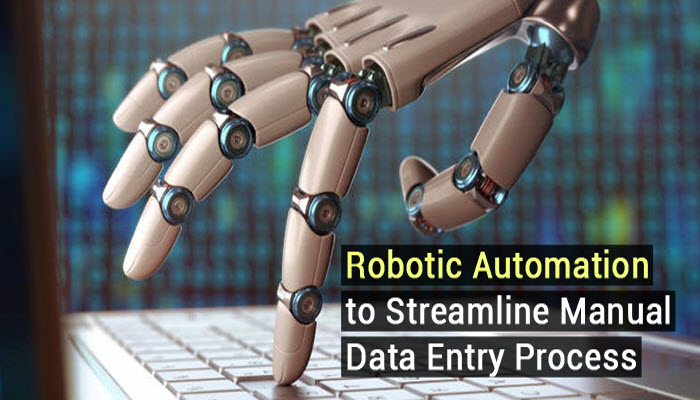
1000+
customers

50+ countries
across the world

Outsourcing leader
since 2008

Technology-driven
services

Stringent
quality processes
How to Streamline Data Entry Processes with Robotic Automation?
Last updated: 05 Mar, 2024 By Bibin Dominic | 6 Minutes Read

With the rise in Artificial Intelligence in robotic technologies, businesses are abuzz with the introduction of Robotic Process Automation (RPA). RPA is replacing repetitive and tedious tasks that used to consume hours of manual work, resulting in immense benefits. These include savings in costs, automating routine desktop work, and increasing overall productivity.
Most importantly, to make optimum use of RPA, fresh investments in upgrading existing systems is not necessary. RPA seamlessly integrates into existing hardware and software so that there is a total and comprehensive improvement in operational efficiencies. Today, top-of-the-line data entry services have shifted to RPA platforms to offer optimum customer care and support to their clients.
What is Robotic Process Automation (RPA)?
RPA works similarly to a software robot that can be programmed to do the functions of a human operator. It can be taught to make use of computer programs just like a human being. It is extremely versatile and can seamlessly integrate into current business operations and models. However, the key point here is that it is not a substitute for human beings; instead, it complements and adds to the quality of output of human-operated processes.
These are generally in areas where humans have to perform high volumes of fixed and rules-driven recurring tasks that do not require any decision-making or application of discretionary powers. Business processes that have gained a cutting-edge advantage because of RPA are back-office work, administrative tasks, workflow processes, IT support, and remote infrastructures. Robotic technologies at work greatly enhance output and accuracy levels with RPA.
How does RPA facilitate manual Data Entry Processes?
Businesses that simply cannot afford to incorporate full automation systems in their data entry processes can fall back on RPA. As said before, RPA cannot replace human capabilities, but its potential to facilitate the process and add value to various segments of an organization is enormous. Automated technologies like RPA work in close coordination with people, leading to the constant exchange of information to reach business goals.
The example of manual data entry is a case in point. Companies, whether handling data entry in-house or outsourcing it, understand the pivotal role of the human element in executing fundamental aspects of the process. Tasks such as ensuring accurate data entry and generating reports in the desired format rely on human intervention. Recognizing that data entry requires human insight and judgment, RPA plays a crucial role by introducing automation into routine manual entry, resulting in heightened accuracy, improved business outcomes, and enhanced compliance.
RPA leverage on latest data entry outcomes
Robotic Process Automation has a great role to play in leveraging the manual data entry process to meet the needs of the modern digital age. Here are some of the ways RPA influences data entry processes. The benefits that accrue from it are optimally used by data entry services to provide the best results to clients.
- Complementing human data entry with more accurate processes.
- Accelerating the collation of data from various sources into a single format.
- Assisting in data entry to prevent errors and maintain high data quality, integrity, and consistency.
- Sometimes, connecting third-party systems is only possible through IT solutions and digital platforms.RPA helps in the process of linking external systems.
- Tedious work of data entry is hastened so that the same workers can be allotted to other activities to add value to the company.
- RPA blends into various data-related scenarios such as data cleansing, data extraction, data enrichment, data de-duplication, and data mining. When business owners outsource data entry, specialized agencies actively employ RPA for the entire data processing cycle.
- Improving the total flow of manual data processing from entry to reporting generation.
- RPA assists data entry operators to achieve a high degree of accuracy, especially in areas like re-keying, which are prone to errors. This is because RPA can automate certain stages of the process, thereby facilitating humans to make considered and intelligent decisions during the manual data entry cycle.
- RPA is no way a means to reduce the labor force. It is, in fact, a way to increase productivity and enhance organizational values through increased operational efficiencies.
RPA as a vehicle for Better Human Manual Data Entry
RPA is a boon to industries and businesses as it augments the abilities of human personnel and improves upon systems and operational infrastructure in force. The software breaks down complex manual data into actionable segments, thereby helping companies make optimized decisions on key business parameters.
Data entry services are today making maximum use of RPA to churn out the top-of-the-line data processing results for their clients. RPA, in short, is the most modern of human capability-enhancing tools and technology.
Read More: Manage Your Business with Online Data Entry Services: Tips & Tricks
If you are looking to outsource data entry to an agency that uses RPA technology, Cogneesol should be your first choice. Over the past decade, we have helped our clients get the best data entry process results. For more information, write to us at [email protected] or call +1 646-688-2821.
Latest Blogs

This site is protected by reCAPTCHA. Google's Privacy Policy
and Terms of Service apply.









